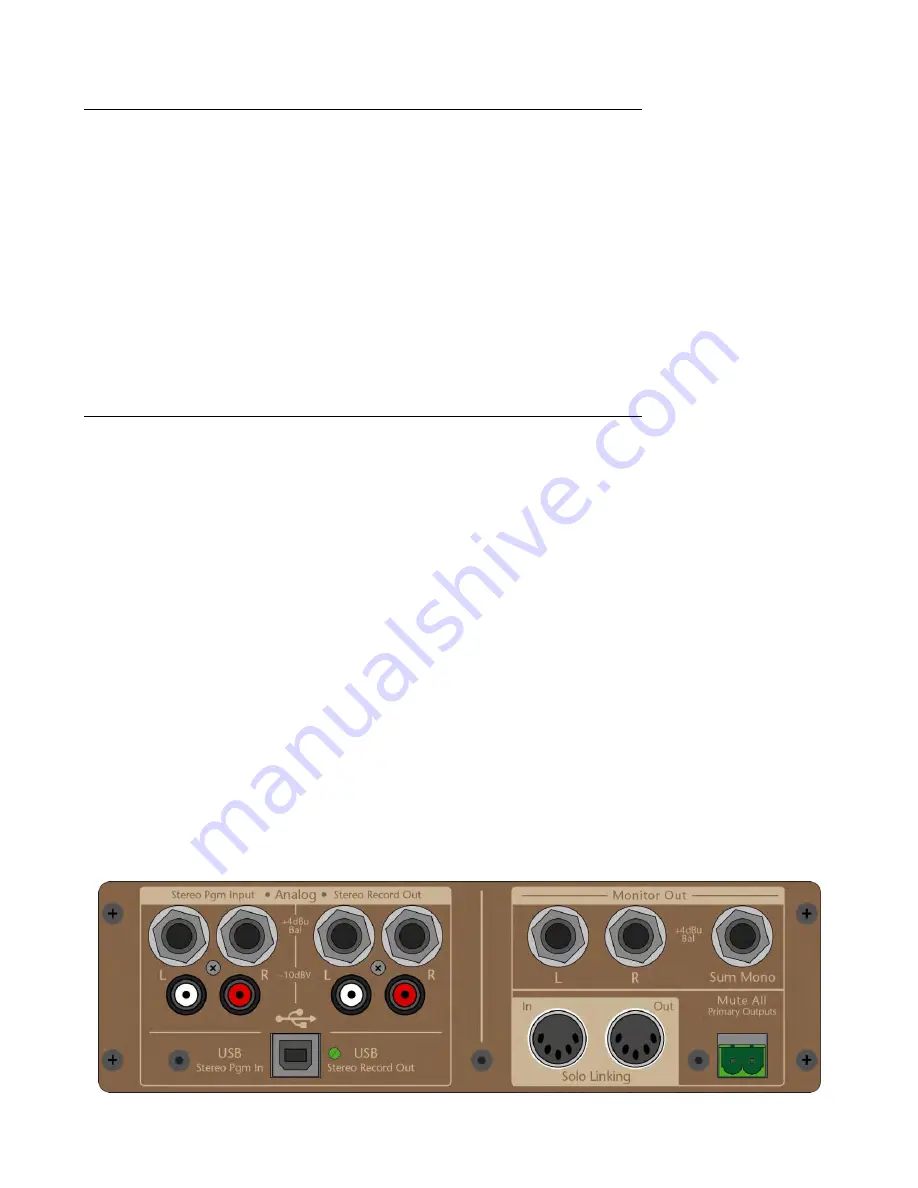
ProDesk-4 OWNER’S MANUAL
31
REAR PANEL CONNECTIONS for Stereo Program In and Stereo Record Out
Most connections for the Stereo Program Input and Stereo Record Out are located on this Master Interface Panel (shown
below). The only additional connection for the Stereo Program In is the Top Analog mini jack located on the Master Module
top panel.
Stereo Program Input: 1/4” TRS Balanced Input + RCA Unbalanced Input
These connectors are the “Rear Analog” source for the Stereo Pgm Input. Both sets of connectors can be used simultaneously;
the TRS and RCA signals will be mixed together and available as a single stereo source.
If only a mono source is available, plugging into just the Left TRS jack will feed both the left & right circuits; the right TRS jack
is connected to the left jack through its normalling contacts. Inserting a plug into the right jack will break this normalled
connection. There is no such normalling for the RCA jacks; use a Y-cord if a mono signal needs to feed both left & right sides.
Stereo Record Out: 1/4” TRS Balanced RCA Unbalanced Output
These connectors are fed from the Stereo Record Output circuitry. Both sets of connectors can be used simultaneously.
The TRS output is impedance-balanced with an output impedance of 200 Ω; design level is +4dBu
The RCA outputs are unbalanced, 1k Ω and are designed to feed a 10KΩ or higher load; design level is –10dBV
USB Audio In & Out
The ProDesk-4 will appear as a USB-peripheral to your computer; there is on onboard circuitry (CODEC) that allows 2-way
stereo communication via USB. Simultaneous record and playback of audio is possible using commonly available software.
Note: CODEC is the term for an enCOder/DECoder. A single CODEC chip is used in the ProDesk for bi-directional USB
conversion and communication: Burr-Brown PCM2900. A USB B-Type connector is provided.
The USB Audio Out (to the computer) can be driven from the same audio signals feeding the Stereo Record Out; the top
panel USB-On switch will feed that audio to the input of the CODEC.
USB Audio In (from the computer) can feed the Stereo Program In section (top panel switch labeled Rear USB) and also feeds
the alternate input of Stereo Input D.
When plugged into the USB port of a computer, the ProDesk will show up as a “USB Audio CODEC” in both Windows and Mac
OS X. Use the “System Preferences- Sound” (OS X) or “Control Panel- Sounds and Audio Devices” (Windows) to select the
ProDesk as your Input or Output device and to adjust any system-controlled parameters (balance & volume).
By default, the internal CODEC is bus-powered by the computer’s USB port; the LED will illuminate when power is available
for the CODEC chip. The analog electronics surrounding the CODEC chip is console-powered for best performance and
headroom. The CODEC is capable of stereo, 16-bit operation at 33, 44, and 48kHz sample rates. The computer sets all CODEC
parameters; there are no user controls on the console itself. When used without additional program support, the CODEC
defaults to the system-level settings of the computer itself. When used with a recording or editing program, the sample rate,
word length and other parameters of the CODEC are controlled by that program.
With just the computer’s system-level controls, you will be able to select “USB Audio CODEC” from the list of audio devices as
the output source for playback of recorded sounds, songs and cues from the computer.
Any of the recording/editing programs available can use the “USB Audio CODEC” as the input source for direct recordings
from the Console (via the Stereo Record Out section).
Suggested (free) audio editing program: Audacity (for Mac, Win and Linux)
Download at: http://audacity.sourceforge.net/download/
Master Interface Panel
(On rear of console)
Summary of Contents for ProDesk-4
Page 2: ...APB DynaSonics 2...
Page 10: ......
Page 39: ...ProDesk 4 OWNER S MANUAL 39...
Page 40: ...APB DynaSonics ProDesk 4 Owners Manual Rev 0 91 July 2009...
























